Bass boats are specialized watercraft designed primarily for the sport of bass fishing. These vessels feature a unique layout optimized for casting, retrieving, and fish care. Their evolution spans decades, from humble beginnings to modern marvels of engineering and technology.
The first bass boat was developed by Holmes Thurmond Skeeter Fishing Boats in 1948, pioneering a new era in freshwater angling. Over time, advancements in materials, design, and electronics have transformed these boats into high-performance machines. Today’s bass boats boast features like:
- Raised casting decks
- Swivel seats
- Built-in livewells
- Advanced fish finders
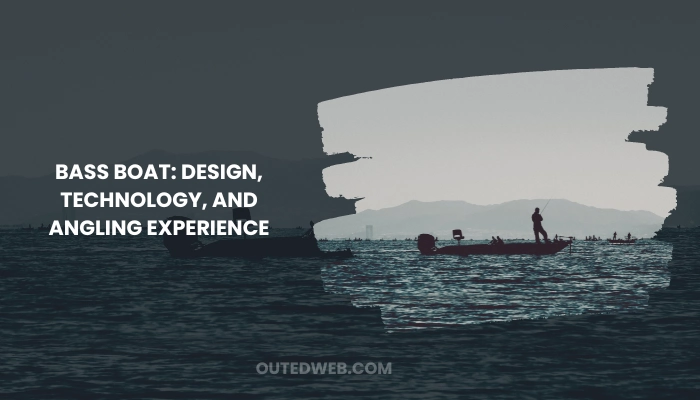
| Basic Features | premium Features |
| Aluminum hull | Fiberglass construction |
| Outboard motor | Trolling motor |
| Dry storage | Aerodynamic designs |
Bass boats have become vital in the quickly expanding sport of competitive bass fishing contests. Their tailored abilities permit fishermen to effectively find, catch, and adequately care for their prized hauls, rendering them essential instruments for any dedicated bass angler.
Design and Construction
When it comes to bass boats, every nuance is fastidiously planned to furnish fishermen with the ultimate fishing experience. From the sleek hull contours to the ergonomic deck organization, these vessels are genuine works of art in engineering and functionality. Let’s delve into the intricate world of bass boat architecture and assembly.
Hull Design and Materials
The hull forms the foundation of any bass boat, and its architecture plays a pivotal role in determining the vessel’s functionality in the water. The two most common substances used in hull building are aluminum and fiberglass, each offering its own set of benefits.
Aluminum hulls are renowned for their light yet resilient nature, making them a well-liked choice for many anglers. These hulls are reasonably affordable and straightforward to maintain, ensuring that your bass boat remains in top condition for years ahead. However, it’s significant to note that aluminum can be susceptible to denting and corrosion if not properly looked after.
On the other hand, fiberglass hulls provide superior toughness and rigidity, allowing for larger boat designs with more spacious layouts. These hulls are known for their sleek appearance and smooth voyage, making them a favorite among serious bass anglers. While fiberglass boats tend to be more expensive than their aluminum counterparts, they often furnish better handling and the ability to accommodate larger outboard motors.
In recent years, some manufacturers have even started experimenting with carbon fiber hulls, which offer an unparalleled blend of strength, lightweight, and performance. However, these cutting-edge materials come with a premium price tag, making them a luxury choice for the most dedicated anglers.
Deck Layout and Features
The deck layout of a bass boat is designed with one primary goal in mind: maximizing the angler’s ability to fish effectively and efficiently. One of the most distinctive features is the raised casting deck, which provides an elevated platform for casting and retrieving lures. This design not only improves visibility but also offers a more ergonomic fishing experience, reducing strain on the back and shoulders.
Another essential component is the abundance of storage compartments, which allow anglers to keep their tackle, rods, and other equipment organized and within easy reach. Many bass boats also feature built-in livewells, specially designed to keep caught fish alive and healthy until they can be released or weighed during a tournament.
Propulsion Systems
Bass boats typically rely on two primary propulsion systems: outboard motors and trolling motors. The outboard motor is responsible for propelling the boat at higher speeds, allowing anglers to quickly navigate from one fishing spot to another. These powerful engines come in various sizes and configurations, with larger models capable of reaching impressive top speeds.
However, once an angler has reached their desired fishing location, the trolling motor takes over. These electric motors provide precise, quiet propulsion, allowing the angler to stealthily move through the water without spooking the fish.
Many modern trolling motors feature advanced features like GPS anchoring and remote control, further enhancing the angler’s ability to navigate and position the boat with pinpoint accuracy.
| Propulsion System | Key Advantages |
| Outboard Motor | High speed, powerful propulsion |
| Trolling Motor | Quiet, precise maneuvering |
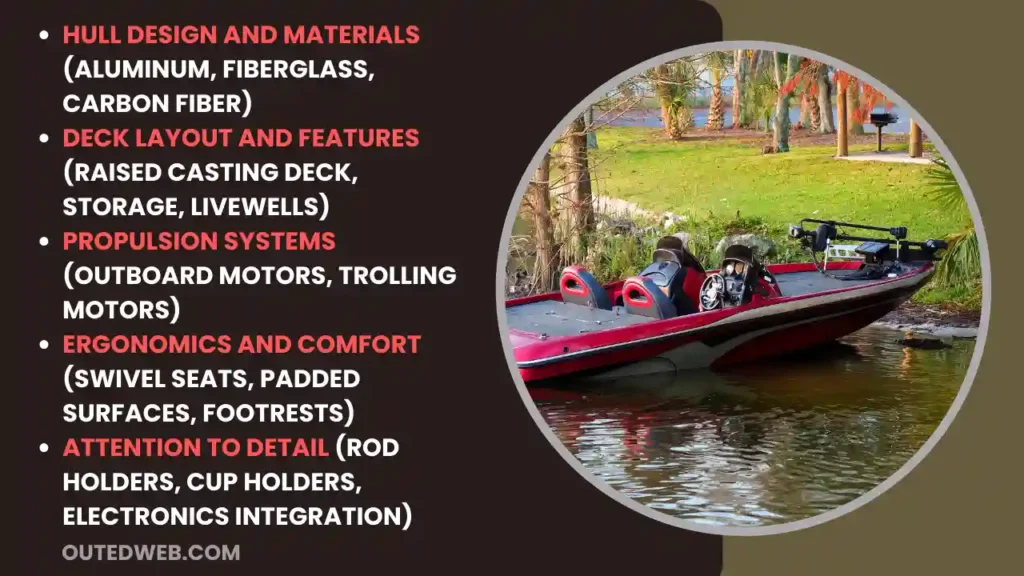
Ergonomics and Comfort
While performance and functionality are undoubtedly crucial, the design of a bass boat also prioritizes the angler’s comfort and ergonomics. After all, anglers often spend long hours on the water, and a well-designed boat can make a significant difference in their overall experience.
One notable feature is the inclusion of swivel chairs or pedestals, which allow anglers to rotate and adjust their position as needed, reducing strain on the back and neck. Additionally, many bass boats feature padded surfaces and footrests, providing much-needed support during those extended fishing sessions.
Attention to Detail
It’s the attention to detail that truly sets apart a well-crafted bass boat from the rest. Manufacturers meticulously consider every aspect of the design, from the placement of rod holders and cup holders to the integration of advanced electronics and fishfinders.
These small touches not only enhance the overall fishing experience but also demonstrate the level of craftsmanship and dedication that goes into creating these exceptional vessels.
Advanced Technology
In the ever-evolving world of bass fishing, technology has become an indispensable ally for anglers seeking to gain a competitive edge. From cutting-edge electronics to innovative power management solutions, the integration of advanced technology has revolutionized the way we approach this exhilarating sport. Let’s explore the cutting-edge features that are transforming the bass fishing experience.
Electronics
At the forefront of bass boat technology are the sophisticated electronics that serve as an angler’s eyes and ears on the water. GPS systems and chart plotters have become essential tools, providing detailed mapping and navigation capabilities that make it easier than ever to pinpoint prime fishing locations and track your every move on the water.
But the true game-changers are the advanced fish finders and sonar systems that reveal the secrets lurking beneath the surface. With the ability to detect fish, underwater structures, and even water temperature and depth, these high-tech gadgets offer a level of precision and insight that was once unimaginable.
Wireless Connectivity and Mobile Apps
In the age of digital connectivity, bass fishing has embraced the power of wireless technology and mobile apps. Many top-of-the-line bass boats now feature built-in Wi-Fi hotspots, allowing anglers to access a wealth of information and services right from their smartphones or tablets.
These wireless capabilities not only enhance the social aspect of the sport but also open up new opportunities for learning and collaboration.
But the true potential of mobile apps lies in their ability to integrate with your boat’s electronics, providing a seamless and intuitive interface for controlling and monitoring various systems.
From adjusting your trolling motor’s speed to monitoring battery levels and even tracking weather patterns, these apps put the entire bass fishing experience at your fingertips.
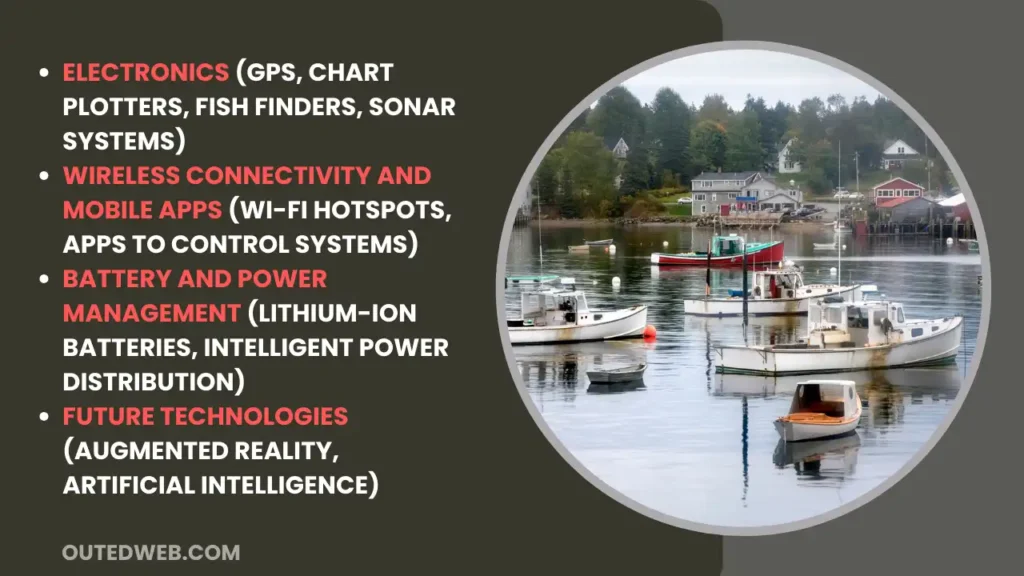
Advancements in Batteries and Power Management
In the world of bass fishing, reliable power is the lifeblood that keeps your electronics and systems running smoothly. Traditional lead-acid batteries have long been the industry standard, but their limitations in terms of weight, capacity, and maintenance have paved the way for innovative alternatives.
Enter the realm of lithium-ion batteries, which offer a remarkable combination of lightweight design, superior energy density, and virtually maintenance-free operation. These advanced batteries not only provide longer run times for your electronics and trolling motors but also contribute to improved fuel efficiency and overall boat performance.
Power management systems, these intelligent systems seamlessly monitor and distribute power across your boat’s various components, ensuring optimal efficiency and preventing costly battery drainage or system failures.
As technology continues to evolve, the possibilities for bass fishing become ever more exciting. From augmented reality displays that overlay real-time data onto your surroundings to artificial intelligence systems that analyze patterns and provide personalized recommendations, the future promises to be a thrilling blend of cutting-edge innovation and timeless angling traditions.
The Fishing Experience
Ah, the thrill of the hunt! Casting your line into the water and anticipating that electrifying tug on the other end—this is the essence of bass fishing. But as any seasoned angler knows, the true art lies in mastering the techniques and leveraging the advanced technology at your disposal.
Maneuverability and Stability
The area is surrounded by tight channels and hidden structures; this is where the unparalleled maneuverability of a bass boat truly shines. With a deft touch on the trolling motor, you effortlessly navigate through the maze, positioning your vessel in the perfect striking position.
But maneuverability is just one part of the equation. True mastery lies in the stability of the platform from which you cast. That’s why bass boats are engineered with wide beams and a low center of gravity, providing a rock-solid foundation that allows you to focus solely on perfecting your technique.
Casting and Retrieving Tactics
The thrill of the cast, the anticipation of the strike—this is what bass fishing is all about. With a bass boat’s specialized design, you’ll have every advantage at your disposal to hone your casting and retrieving skills.
From the elevated casting decks that offer unobstructed lines of sight to the strategically placed rod holders, every aspect of these vessels is tailored to enhance your angling prowess.
Whether you’re finessing a top water lure across a glassy surface or ripping a crank bait through submerged timber, you’ll be able to execute your techniques with precision and finesse. But the true magic happens when you combine your skills with the advanced electronics at your fingertips.
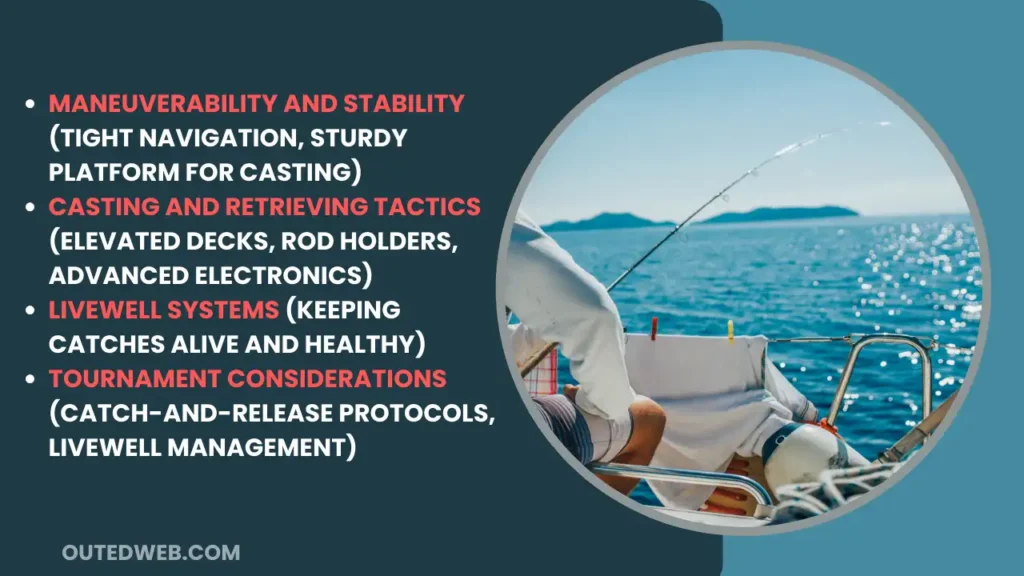
Livewell Systems
For many anglers, the thrill of the catch is only half the battle. Preserving the health and well-being of their prized catches is equally important, especially in the competitive world of bass fishing tournaments. This is where the advanced livewell systems of bass boats truly shine.
These specialized tanks are designed to keep your catches alive and vibrant, circulating oxygenated water and maintaining optimal temperatures. Whether you’re practicing catch-and-release or preparing for a weigh-in, these systems ensure that your bass remains in peak condition, ready to be released back into the water or proudly displayed on the tournament stage.
Tournament Considerations
For the true bass fishing enthusiast, the allure of competitive tournaments is hard to resist. These high-stakes events demand not only exceptional angling skills but also a deep understanding of the nuances of tournament fishing.
From adhering to strict catch-and-release protocols to mastering the art of live-well management, success in these events hinges on your ability to seamlessly blend technique and technology.
Maintenance and Care
Owning a bass boat is both a privilege and a responsibility. Just like a finely tuned instrument, these vessels require diligent care and maintenance to ensure they continue performing at their peak. From regular cleaning and storage to engine upkeep and off-season preparation, let’s explore the essential steps to keep your bass boat in top condition.
Cleaning and Storage
After a day of intense fishing, your bass boat may be adorned with the battle scars of success—dried mud, tangled lines, and a hint of that unmistakable fish aroma. While these signs are badges of honor, they also serve as a reminder to properly clean and store your vessel.
Regular cleaning not only preserves the aesthetic appeal of your bass boat but also prevents the buildup of corrosive elements that can compromise its structural integrity over time. From the hull to the livewells, a thorough scrub-down with the right cleaning products is essential.
Proper storage is equally crucial, especially during the off-season. Whether it’s a covered slip, a garage, or a well-ventilated storage facility, protecting your bass boat from the elements can significantly extend its lifespan and maintain its resale value.
Engine Maintenance
The engine is the beating heart of your bass boat, propelling you across the water and delivering the power you need to reach those prime fishing spots. Neglecting regular maintenance can lead to costly repairs and potential breakdowns, putting a damper on your fishing adventures.
From oil changes and filter replacements to inspecting the cooling system and fuel lines, staying on top of your engine’s maintenance schedule is crucial. Additionally, familiarizing yourself with basic troubleshooting techniques can help you address minor issues before they escalate into major problems.
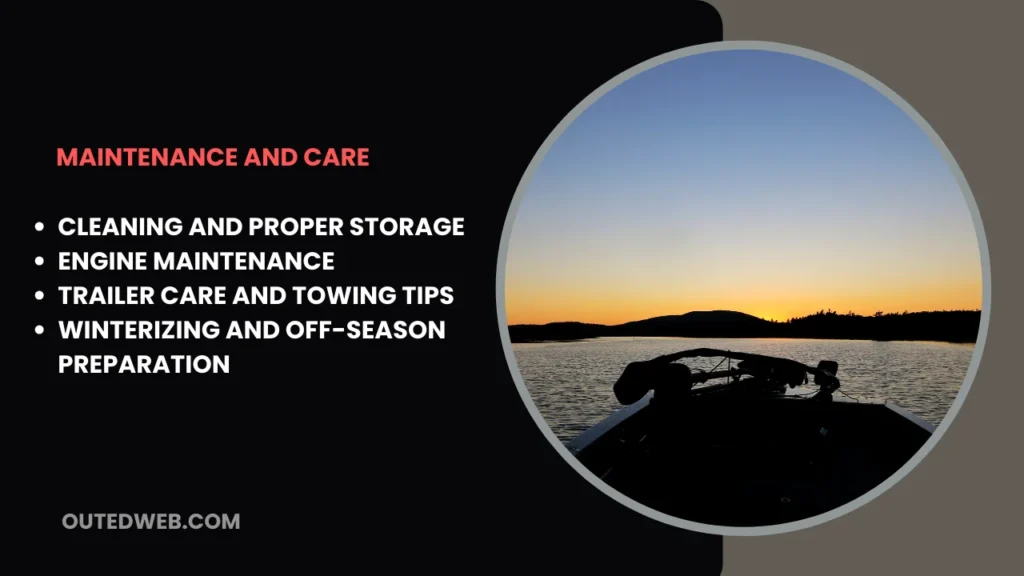
Trailer Care and Towing Tips
For many bass anglers, the journey to the water begins with loading their beloved vessel onto a trailer. Maintaining your trailer’s integrity is just as important as caring for the boat itself.
Regular inspections of the tires, bearings, and trailer lighting systems can prevent breakdowns and ensure a smooth ride. Additionally, following proper loading and securing techniques is essential for safe transportation, protecting your investment and the vehicles around you.
When it comes to towing, patience and caution are key. Navigating tight turns, steep inclines, and busy highways requires focus and skill. Taking the time to practice and familiarize yourself with your towing setup can make all the difference in ensuring a stress-free and safe journey.
Winterizing and Off-Season Preparation
As the seasons change and the water temperatures drop, it’s time to think about winterizing your bass boat. This process involves a series of steps designed to protect your vessel from the harsh effects of freezing temperatures and prolonged inactivity.
From draining the livewells and flushing the engine to removing batteries and covering the boat with a breathable material, proper winterization ensures that your bass boat emerges from hibernation ready to tackle the waters once again.
Buying a Bass Boat
Now, let’s turn our attention to the exciting prospect of acquiring your very own bass boat. Whether you’re a seasoned angler or a newcomer to the sport, the process of buying a bass boat can be both exhilarating and daunting.
New vs. Used Boats
The age-old debate: should you opt for a brand-new bass boat or explore the world of pre-owned vessels? Both options have their merits and drawbacks.
New boats offer the latest designs, features, and technologies straight from the manufacturer, along with the peace of mind of a warranty and pristine condition. However, they often come with a higher price tag and immediate depreciation.
On the other hand, used bass boats can provide excellent value for money, especially if you’re willing to invest time in finding a well-maintained model. However, it’s crucial to thoroughly inspect the boat and its components to ensure you’re making a sound investment.
Popular Brands and Models
The bass boat market is filled with a diverse range of brands and models, each with its own unique characteristics and capabilities. From the sleek and powerful offerings of Ranger and Skeeter to the versatile and affordable options from Tracker and Nitro, the choices from brands like Bass Cat, Lowe, Champion, Xpress, G3, and Stratos can be overwhelming.
Researching and comparing different models is essential to finding the perfect fit for your fishing style, budget, and desired features. Don’t be afraid to seek advice from experienced anglers or attend local boat shows to get a hands-on feel for the various options available.

Customization Options
For many bass boat enthusiasts, the true delight lies in customizing their vessels to reflect their personal style and preferences. From specialized electronics and fishing accessories to custom wraps and graphics, the possibilities for personalization are endless.
Working with reputable dealers and aftermarket suppliers can open up a world of options, allowing you to craft a bass boat that not only performs exceptionally but also reflects your unique identity on the water.
Financing and Insurance Considerations
Purchasing a bass boat is a significant investment, and proper planning is crucial to ensuring a smooth and stress-free process. Exploring financing options, such as loans or leasing arrangements, can help make your dream boat more attainable.
Additionally, securing adequate insurance coverage is essential to protecting your investment and providing peace of mind on the water. From hull and liability coverage to specialized policies for tournament fishing, working with knowledgeable insurance providers can ensure you’re fully prepared for any eventuality.
Frequently Asked Questions
What Is the Difference Between Aluminum And Fiberglass Bass Boats?
Aluminum bass boats are typically lighter, more affordable, and easier to maintain, but they may offer less interior space and be more susceptible to denting. Fiberglass boats, on the other hand, are more durable, provide better handling, and can accommodate larger outboard motors, but they tend to be more expensive.
How Important Is the Livewell System in a Bass Boat?
The livewell system is crucial for keeping caught fish alive and healthy, especially in tournament settings. It ensures that your catches remain in peak condition for release or weigh-in, making it an essential feature for any serious bass angler.
What Are the Essential Electronics for Bass Fishing?
Essential electronics for bass fishing include GPS navigation systems, fish finders and sonar, and chartplotters. These tools help anglers locate fish, navigate waterways, and gain valuable insights into underwater structures and conditions.
How Do You Choose the Right Outboard Motor for Your Bass Boat?
When choosing an outboard motor, consider factors such as the size and weight of your boat, the desired top speed, and the type of water you’ll be fishing in. Consult with knowledgeable dealers or manufacturers to find the right balance of power, fuel efficiency, and reliability.
How Can You Improve Fuel Efficiency in Your Bass Boat?
Techniques for improving fuel efficiency include maintaining proper boat trim, reducing unnecessary weight, using the right propeller pitch, and avoiding excessive idling or high-speed operation when not necessary.
What Are the Best Practices for Trailering And Launching a Bass Boat?
Best practices include properly securing the boat to the trailer, checking tire pressure and trailer lights, using caution when backing up and launching, and being mindful of ramp etiquette and safety protocols.
How Do You Maintain And Winterize Your Bass Boat Properly?
Proper maintenance includes regular cleaning, engine servicing, and addressing any issues promptly. Winterization typically involves draining livewells, flushing the engine, removing batteries, and covering the boat to protect it from the elements.
What Are the Top Brands And Models to Consider When Buying a Bass Boat?
Popular bass boat brands include Ranger, Skeeter, Nitro, Tracker, Triton, Bass Cat, and Xpress, among others. Research various models and consult with knowledgeable dealers to find the best fit for your needs and budget.
Can You Customize a Bass Boat to Suit Your Specific Fishing Needs?
Absolutely! Bass boats can be customized with specialized electronics, fishing accessories, custom wraps and graphics, and other personalized features to tailor the experience to your preferences.
How Much Does a New Bass Boat Typically Cost, And What Financing Options Are Available?
The cost of a new bass boat can range from $20,000 to over $100,000, depending on the size, brand, and features. Financing options often include loans or leasing arrangements through dealerships or financial institutions, making these investments more accessible.
Final Verdict
Bass fishing is a journey where the bass boat serves as more than a vessel—it’s a canvas for crafting the ultimate fishing experience. With meticulously engineered hulls and cutting-edge technology, these boats embody passion and innovation.
Bass boats elevate angling adventures with precision electronics and intuitive ergonomics. They facilitate navigating narrow channels and hidden coves, enhancing the thrill of the hunt.
Beyond the boat, it’s a celebration of nature and the art of angling, where each catch becomes a cherished memory. Looking ahead, innovation in materials and technology promises to redefine possibilities on the water.
Whether an experienced angler or a novice, embrace the allure of the bass boat, immerse yourself in the camaraderie, and cherish the memories. In bass fishing, the true essence resides in the connection with nature and the memories crafted, rather than the magnitude of the catch.

